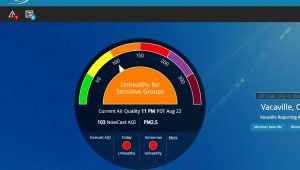Public Health Notices
Water and Air Quality
Water
If your home is served by a public water service provider, you will want to contact them directly for updates.
- SID: https://www.sidwater.org/
- Rural North Vacaville: https://rnvwd.com/
- City of Vallejo Lakes Water System https://www.cityofvallejo.net/city_hall/departments___divisions/water_department
Check for ash and fire related debris that may have contaminated your water supply. Loss in pressure of your water supply can also introduce bacteriological contamination to the system. Contact Solano County Environmental Health for more information at (707) 784-6765.
If you are on a well and suspect your water supply has been contaminated, you should attempt to obtain an alternative source of supply such as bottled water or other beverages for drinking.
Should you be in a position whereby it is necessary to continue to drink water from the suspect water supply, you must treat the water by one of the following methods:
- Bring water to a rolling boil for a minimum of three (3) to five (5) minutes. If unsure as to effectiveness of disinfection, you may want to boil water up to ten (10) minutes.
- Disinfect with unscented household chlorine bleach. Use two (2) drops of chlorine bleach per quart of water or eight (8) drops per gallon. For cloudy water, first strain through a clean cloth, then add four (4) drops of chlorine to each quart, or sixteen (16) drops to each gallon. Stir or shake the water after the chlorine has been added and let stand for thirty (30) minutes before consuming.
Do not use contaminated water to make ice, brush your teeth or wash dishes.
If you have a private well:
There are number of things to keep in mind if you have had fire damage that compromised your well: When it is safe to do so you can check for:
✔ Damaged and melted or exposed electrical wiring
✔ Damaged and melted PVC casing, liner, or pipe
✔ Damaged well houses and pressure tanks
✔ Debris, ash, sediment, entering uncovered wells
Do the Following:
✔ Barricade / flag the area around the area of the well as a warning
✔ Contact a licensed and bonded well driller or a pump installer to determine the extent of damage and what must be done to repair or destroy the well
✔ If you think the fire damaged your water supply, bring water back with you when you return home.
Do Not
✔ Handle wiring that has been damaged by fire
✔ Do not touch the casing
Wells must be maintained to prevent health hazards. Take steps to ensure your water is safe to drink after an emergency.
Should you be in a position whereby it is necessary to continue to drink water from the suspect water supply, you must treat the water by one of the following methods:
-
- Bring water to a rolling boil for a minimum of three (3) to five (5) minutes. If unsure as to effectiveness of disinfection, you may want to boil water up to ten (10) minutes.
- Disinfect with unscented household chlorine bleach. Use two (2) drops of chlorine bleach per quart of water or eight (8) drops per gallon. For cloudy water, first strain through a clean cloth, then add four (4) drops of chlorine to each quart, or sixteen (16) drops to each gallon. Stir or shake the water after the chlorine has been added and let stand for thirty (30) minutes before consuming.
Disinfection of Private Domestic Water Wells
Disinfection of a well is recommended to eliminate disease causing organisms. A well should be disinfected following a repair, maintenance or replacement of the pump or if the power has been off for an appreciable period possibly causing the pressure tank to lose pressure and the distribution system to back siphon into the well causing possible contamination. Disinfection generally involves five (5) steps:
Remove the threaded inspection plug from the cap on top of the well. Place a funnel in this entry port and pour one (1) to three (3) gallons of domestic 5.25% chlorine bleach into the well. Should you wish to be more precise in this effort, introduce one gallon of bleach per 1000 gallons of water. You may calculate this as follows:
a) Determine the amount of water in the well using the following formula:
TOTAL WELL DEPTH – STANDING WATER LEVEL = FEET
________________ – ____________________ = ____
b) Take the gallons per foot (gpf) using the chart below times the number of feet to determine capacity.
WATER IN WELL x GALLON PER FOOT = TOTAL GALLONS
___________ ft x gpf ___________ = _____________
4″ Well has .65 gallons per foot
5″ Well has 1.04 gallons per foot
6″ Well has 1.47 gallons per foot
7″ Well has 2.00 gallons per foot
8″ Well has 2.61 gallons per foot
c) Determine the amount of chlorine needed to disinfect the well. Remember, you need use only one gallon of .25% bleach per thousand gallons of water!
✔ Open all faucets until the odor of chlorine is detected at water outlets, including faucets or fittings, sprinklers, drip lines, irrigation lines, etc.
✔ Close all outlets and allow water to remain in all water lines and well, preferably overnight or longer if possible. Be sure to limit water usage during these critical hours.
✔ The next day or longer open all outlets until the odor of all chlorine has disappeared. The water supply should then be free of all chlorine.
✔ Have the water sampled by a state certified laboratory for bacteriological quality.
Note: Disposal of chlorinated water should be done away from trees, shrubs, lawns, ponds and streams. It is important to avoid discharging highly chlorinated water in large volumes into septic tank systems.
Should water be in scarce supply, alternative temporary sources may include hot water tanks, toilet tanks (if no chemical disinfectant is used), canned fruit and vegetable juices and liquid from other canned goods.
Once again, be sure to disinfect all suspect sources.
Air Quality
It's smoky out there. Here are some tips and resources about local air quality in Solano County.
-
- Stay indoors and keep your windows closed.
- Use “controller” steroid inhalers (like QVAR) as prescribed.
- Use “quick relief” inhalers to help with shortness of breath.
- If you have oxygen, use it if you have difficulty breathing.
- Turn on your air conditioner to see if it helps, especially if it’s central air. If you have a window A/C unit, make sure the filter is clean.
- Use fans in each room to help move the air in your house.


